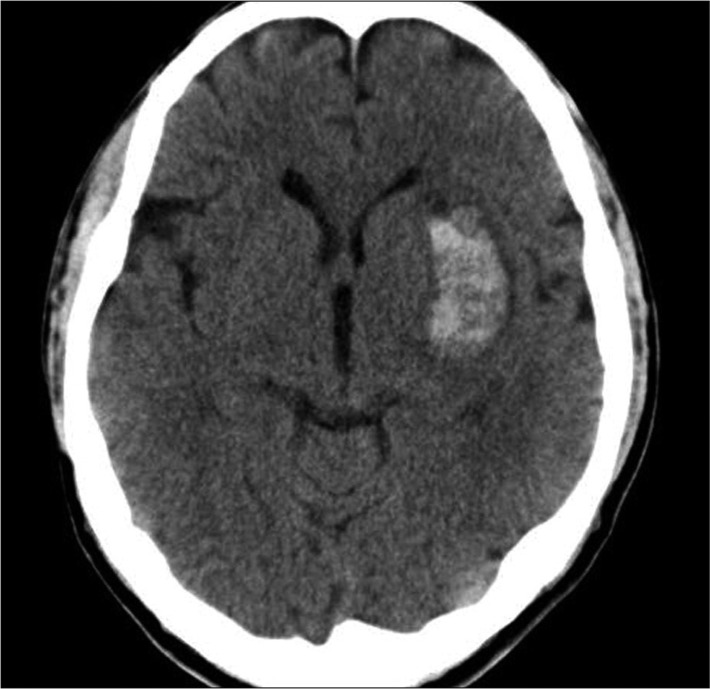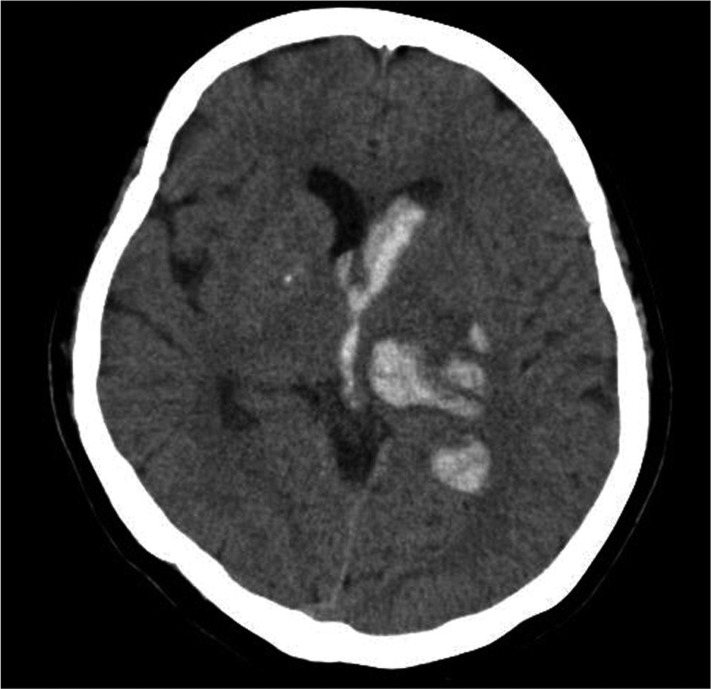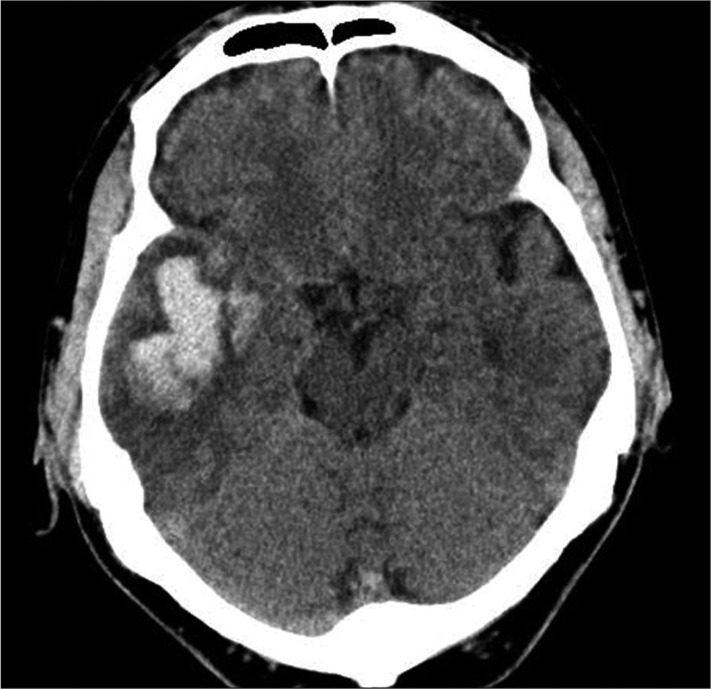J Korean Neurosurg Soc.
2012 Oct;52(4):312-319. 10.3340/jkns.2012.52.4.312.
Seizures after Spontaneous Intracerebral Hemorrhage
- Affiliations
-
- 1Department of Neurosurgery, Dongguk University College of Medicine, Seoul, Korea. drseraph@lycos.co.kr
- 2Department of Neurosurgery, Dongguk University Ilsan Hospital, Goyang, Korea.
- KMID: 2190646
- DOI: http://doi.org/10.3340/jkns.2012.52.4.312
Abstract
OBJECTIVE
In patients with spontaneous intracerebral hemorrhage (ICH), the risk factors for seizure and the effect of prophylactic anticonvulsants are not well known. This study aimed to determine the risk factor for seizures and the role for prophylactic anticonvulsants after spontaneous ICH.
METHODS
Between 2005 and 2010, 263 consecutive patients with spontaneous ICH were retrospectively assessed with a mean follow-up of 19.5 months using medical records, updated clinical information and, when necessary, direct patient contact. The seizures were classified as early (within 1 week of ICH) or late (more than 1 week after ICH). The outcomes were measured with the Glasgow Outcome Scale at discharge and the modified Rankin Scale (mRS) at both 2 weeks and discharge.
RESULTS
Twenty-two patients (8.4%; 9 patients with early seizures and 13 patients with late seizures) developed seizures after spontaneous ICH. Out of 263 patients, prophylactic anticonvulsants were administered in 216 patients. The prophylactic anticonvulsants were not associated with a reduced risk of early (p=0.094) or late seizures (p=0.326). Instead, the factors associated with early seizure were cortical involvement (p<0.001) and younger age (60 years or less) (p=0.046). The risk of late seizure was increased by cortical involvement (p<0.001) and communicating hydrocephalus (p=0.004). The prophylactic anticonvulsants were associated with a worse mRS at 2 weeks (p=0.024) and at last follow-up (p=0.034).
CONCLUSION
Cortical involvement may be a factor for provoked seizures. Although the incidence of early seizures tended to decrease in patients prescribed prophylactic anticonvulsants, no statistical difference was found.
MeSH Terms
Figure
Cited by 2 articles
-
Status Epilepticus after Catheter Drainage of Basal Ganglia Hemorrhage
Min Cheol Park, Min Seok Baik, Jun Hong Lee, Jeong Hee Cho, Jieun Lee, Gyu Sik Kim
J Neurocrit Care. 2017;10(1):49-52. doi: 10.18700/jnc.160092.Clinical Practice Guidelines for the Medical and Surgical Management of Primary Intracerebral Hemorrhage in Korea
Jeong Eun Kim, Sang-Bae Ko, Hyun-Seung Kang, Dae-Hee Seo, Sukh-Que Park, Seung Hun Sheen, Hyun Sun Park, Sung Don Kang, Jae Min Kim, Chang Wan Oh, Keun-Sik Hong, Kyung-Ho Yu, Ji Hoe Heo, Sun-Uck Kwon, Hee-Joon Bae, Byung-Chul Lee, Byung-Woo Yoon, In Sung Park, Joung-Ho Rha
J Korean Neurosurg Soc. 2014;56(3):175-187. doi: 10.3340/jkns.2014.56.3.175.
Reference
-
1. Arboix A, Comes E, Massons J, García L, Oliveres M. Relevance of early seizures for in-hospital mortality in acute cerebrovascular disease. Neurology. 1996; 47:1429–1435. PMID: 8960722.
Article2. Arboix A, García-Eroles L, Massons JB, Oliveres M, Comes E. Predictive factors of early seizures after acute cerebrovascular disease. Stroke. 1997; 28:1590–1594. PMID: 9259754.
Article3. Banks JL, Marotta CA. Outcomes validity and reliability of the modified Rankin scale : implications for stroke clinical trials : a literature review and synthesis. Stroke. 2007; 38:1091–1096. PMID: 17272767.
Article4. Berger AR, Lipton RB, Lesser ML, Lantos G, Portenoy RK. Early seizures following intracerebral hemorrhage : implications for therapy. Neurology. 1988; 38:1363–1365. PMID: 3412583.
Article5. Bladin CF, Alexandrov AV, Bellavance A, Bornstein N, Chambers B, Coté R, et al. Seizures after stroke : a prospective multicenter study. Arch Neurol. 2000; 57:1617–1622. PMID: 11074794.6. Cheung CM, Tsoi TH, Au-Yeung M, Tang AS. Epileptic seizure after stroke in Chinese patients. J Neurol. 2003; 250:839–843. PMID: 12883927.
Article7. De Herdt V, Dumont F, Hénon H, Derambure P, Vonck K, Leys D, et al. Early seizures in intracerebral hemorrhage : incidence, associated factors, and outcome. Neurology. 2011; 77:1794–1800. PMID: 21975203.
Article8. De Reuck J, Hemelsoet D, Van Maele G. Seizures and epilepsy in patients with a spontaneous intracerebral haematoma. Clin Neurol Neurosurg. 2007; 109:501–504. PMID: 17509750.
Article9. Echlin FA, Arnett V, Zoll J. Paroxysmal high voltage discharges from isolated and partially isolated human and animal cerebral cortex. Electroencephalogr Clin Neurophysiol. 1952; 4:147–164. PMID: 13033793.
Article10. Garrett MC, Komotar RJ, Starke RM, Merkow MB, Otten ML, Connolly ES. Predictors of seizure onset after intracerebral hemorrhage and the role of long-term antiepileptic therapy. J Crit Care. 2009; 24:335–339. PMID: 19327321.
Article11. Giroud M, Gras P, Fayolle H, André N, Soichot P, Dumas R. Early seizures after acute stroke : a study of 1,640 cases. Epilepsia. 1994; 35:959–964. PMID: 7925167.
Article12. Commission on Epidemiology and Prognosis, International League Against Epilepsy. Guidelines for epidemiologic studies on epilepsy. Epilepsia. 1993; 34:592–596. PMID: 8330566.13. Gurjar M, Singhal S, Baronia AK, Azim A, Poddar B. Valproate-induced hyperammonemic encephalopathy : a reminder of rare complication of valproate. J Emerg Trauma Shock. 2011; 4:321–322. PMID: 21769226.
Article14. Kase CS, Williams JP, Wyatt DA, Mohr JP. Lobar intracerebral hematomas : clinical and CT analysis of 22 cases. Neurology. 1982; 32:1146–1150. PMID: 6889699.
Article15. Kaye AH, Andrewes D. Glasgow Outcome Scale : research scale or blunt instrument? Lancet. 2000; 356:1540–1541. PMID: 11075764.16. Keene DL, Ventureyra EC. Hydrocephalus and epileptic seizures. Childs Nerv Syst. 1999; 15:158–162. PMID: 10361965.
Article17. Kilpatrick CJ, Davis SM, Tress BM, Rossiter SC, Hopper JL, Vandendriesen ML. Epileptic seizures in acute stroke. Arch Neurol. 1990; 47:157–160. PMID: 2302087.
Article18. Kothari RU, Brott T, Broderick JP, Barsan WG, Sauerbeck LR, Zuccarello M, et al. The ABCs of measuring intracerebral hemorrhage volumes. Stroke. 1996; 27:1304–1305. PMID: 8711791.
Article19. Lipton RB, Berger AR, Lesser ML, Lantos G, Portenoy RK. Lobar vs thalamic and basal ganglion hemorrhage : clinical and radiographic features. J Neurol. 1987; 234:86–90. PMID: 3559644.
Article20. Morgenstern LB, Hemphill JC 3rd, Anderson C, Becker K, Broderick JP, Connolly ES Jr, et al. Guidelines for the management of spontaneous intracerebral hemorrhage : a guideline for healthcare professionals from the American Heart Association/American Stroke Association. Stroke. 2010; 41:2108–2129. PMID: 20651276.
Article21. Naidech AM, Garg RK, Liebling S, Levasseur K, Macken MP, Schuele SU, et al. Anticonvulsant use and outcomes after intracerebral hemorrhage. Stroke. 2009; 40:3810–3815. PMID: 19797183.
Article22. Naidech AM, Kreiter KT, Janjua N, Ostapkovich N, Parra A, Commichau C, et al. Phenytoin exposure is associated with functional and cognitive disability after subarachnoid hemorrhage. Stroke. 2005; 36:583–587. PMID: 15662039.
Article23. Passero S, Rocchi R, Rossi S, Ulivelli M, Vatti G. Seizures after spontaneous supratentorial intracerebral hemorrhage. Epilepsia. 2002; 43:1175–1180. PMID: 12366733.
Article24. Piatt JH Jr, Carlson CV. Hydrocephalus and epilepsy : an actuarial analysis. Neurosurgery. 1996; 39:722–727. discussion 727-728. PMID: 8880764.25. Proposal for revised clinical and electroencephalographic classification of epileptic seizures. From the Commission on Classification and Terminology of the International League Against Epilepsy. Epilepsia. 1981; 22:489–501. PMID: 6790275.26. Reddig RT, Nixdorf KE, Jensen MB. The prophylactic use of an antiepileptic drug in intracerebral hemorrhage. Clin Neurol Neurosurg. 2011; 113:895–897. PMID: 21824722.
Article27. Sahaya K, Goyal MK, Sarwal A, Singh NN. Levetiracetam-induced thrombocytopenia among inpatients : a retrospective study. Epilepsia. 2010; 51:2492–2495. PMID: 21204814.
Article28. Sung CY, Chu NS. Epileptic seizures in intracerebral haemorrhage. J Neurol Neurosurg Psychiatry. 1989; 52:1273–1276. PMID: 2512371.
Article29. Treiman DM. Electroclinical features of status epilepticus. J Clin Neurophysiol. 1995; 12:343–362. PMID: 7560022.
Article30. Wang HC, Chang WN, Chang HW, Ho JT, Yang TM, Lin WC, et al. Factors predictive of outcome in posttraumatic seizures. J Trauma. 2008; 64:883–888. PMID: 18404052.
Article
- Full Text Links
- Actions
-
Cited
- CITED
-
- Close
- Share
- Similar articles
-
- Multiple Spontaneous Intracerebral Hematoma without Presenting Risk Factors
- Computed Tomographic Findings and Clinical Observation of Spontaneous Intracerebral Hemorrhage
- Clinical Analysis for Stereotatic Aspiration and Thrombolysis of Spontaneous Intracerebral Hemorrhage
- Spontaneous Spinal Subdural and Subarachnoid Hemorrhage with Concomitant Intracerebral Hemorrhage: A Case Report
- A Case of Spontaneous Intracerebral Hemorrhage during Ear Surgery under General Anesthesia





